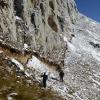Identifying, measuring, modeling and better understanding the factors and processes that contribute to the genesis of earthquakes and characterize their properties
Seismogenesis encompasses all factors and processes which contribute to the genesis of earthquakes. In that field, Geoazur’s researches focus on:
- analyzing the properties of tectonic faults that are sources of large earthquakes and their relations to the properties of earthquakes;
- the observation and modeling of large earthquakes recorded worldwide and the development of dedicated tools;
- the measurement and modeling of earthquake-cycle deformation and change in properties;
- recording and analyzing local micro-seismicity and developing dedicated tools;
- paleoseismic analysis for large prehistoric earthquakes and the measurement of Quaternary deformations;
- the measurement and experimental, mechanical and physical modeling of slip and rupture processes.
In that context, the teams work on:
- the observation and continuous high-frequency measurement of deformations (surface deformation fields, micro-seismicity, slow earthquakes, aseismic deformation) and of change in mechanical properties that contribute to seismogenesis (for natural seismogenic faults, in laboratory and in-situ experiments);
- imaging major subduction faults, especially at sea;
- the empirical characterization of the relationships between the fault properties and the quake ones;
- the kinematic, physical and dynamic modeling of the rupture process (data assimilation procedure and joint inversion, Bayesian approach to uncertainty analysis, dynamic modeling integrating fault properties);
- developing near real time earthquake analysis tools.





